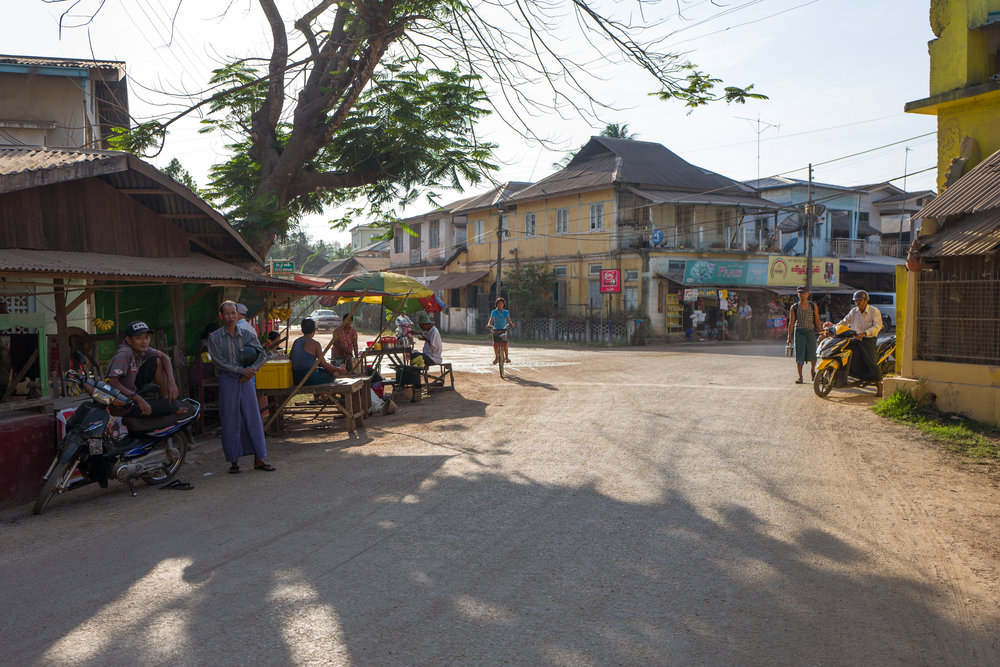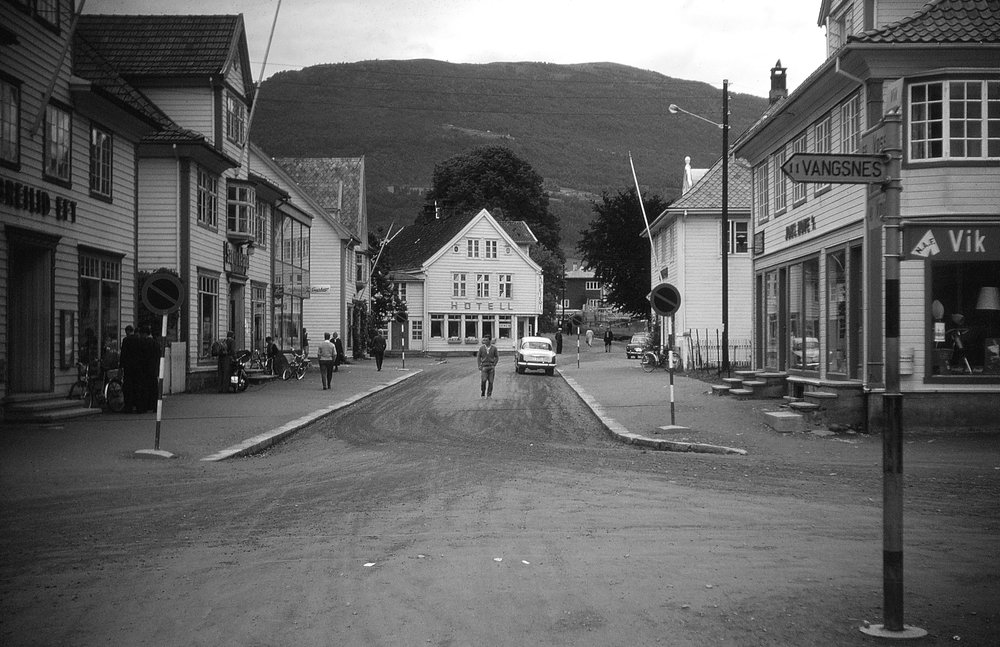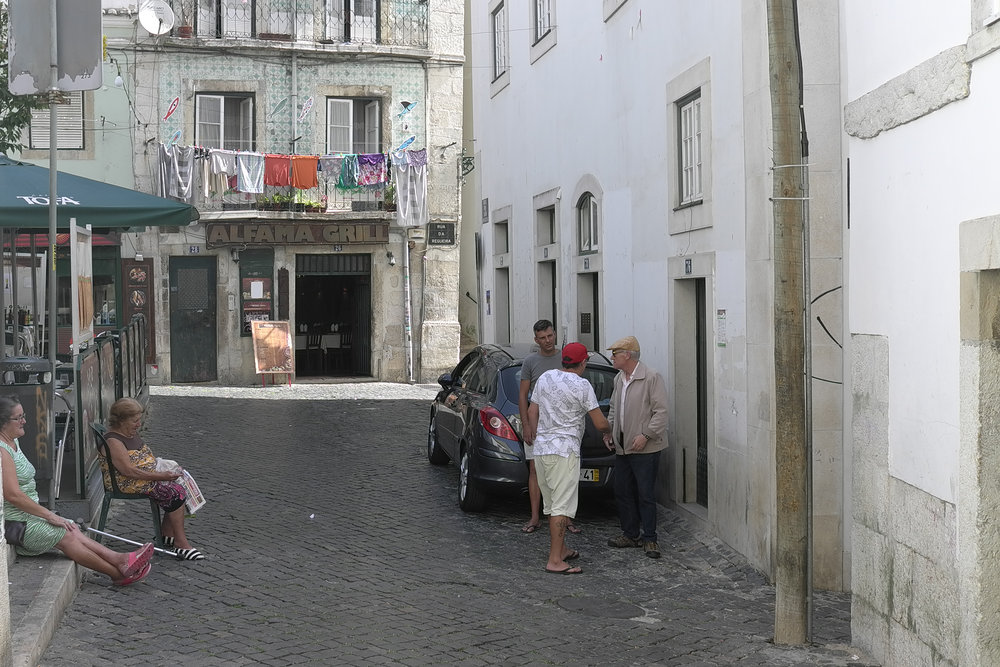This is a story about four photos. The first is above. It was taken by me way back in 1967. It shows a village in central Norway. I cannot name the place. I have tried to pin it down on Google maps using the info on the signpost in the photo, but I cannot make a match. Perhaps there is a Macfilos Norwegian reader out there who can help.
I took it when my then girlfriend (now wife of 49 years) and I were making our way back to the UK after spending two months close to the Arctic Circle in northern Norway doing work for our university theses. It was a wonderful lingering journey back by bus, thumb, train and boat via Oslo, Copenhagen and the Hook of Holland. Amazing to relate, we camped the whole way, carrying everything on our backs. A very different story to today when even a long weekend away requires us each to take a largish suitcase.
In my rucksack (backpack) for the journey was my then recently acquired Leica 3A with its 50mm f/2.8 Elmar lens. I am confident that I took the 50mm Elmar because it was the only lens I had. Sadly there are not many photos from the trip — film was expensive, but also those I did take have been ravaged by time and are now mostly unusable. With hindsight, I must have missed so many great photo opportunities.
I still own that first Leica outfit. I have not used it for perhaps 30 years. A few years ago I bought a cassette of Ilford 35mm film and loaded it, but my enthusiasm soon waned when I realised how tedious it was to use. The film was never finished.
I found the negative of the village about ten years ago and, although it was showing signs of chemical rot, I scanned it in. It had never been printed. Seeing it on the screen, I realised how evocative it is and looking at it you can see a story. It is a slice of life from a very different era.
The village has just a dirt main street. Parking is not a problem. There are few cars. One is a British Hillman Minx, and the other is a Mercedes 190. There is so little traffic one local feels comfortable walking down the middle of the street. The hotel is expecting British tourists going by the lunch sign in the window. The locals use bikes rather than cars. What happens in winter? And is it the same today I wonder.

Finding this picture prompted me to think about capturing similar slice-of-life scenes on my travels. Now, I wish that I had thought of the idea years earlier. Again, all the photo opportunities I have missed. But anyway the seed has been planted, albeit rather late in life. So when I saw the scene above in 2015 out of a bus, I knew it had to be the second scene in my series. Again I cannot identify precisely where it was taken except to say that it was on the road to the Nagarhole Tiger Reserve in Karnataka state in southern India.
This one is another slice of village life. The light was co-operating although the tigers in the reserve — if there were any — weren’t. It is very typically laid-back contemporary rural India. The young men with their motorbikes, the Hindustan Ambassador car and the general store with its banners advertising mobile phone companies. And of course, there is the inevitable litter.
I took this photo with a more contemporary Leica, my X Vario. In between that first 3A and the XV, there had been a Leica M4-P and a much-loved M6. Now all are gone.
It was a good thing that the bus stopped in the village in precisely the right position for the photo; the elevation certainly helps the composition. It was also fortunate that the window slid open as it was filthy. Most Indian rural buses don’t seem ever to have had their windows cleaned. They leave the factory with clean windows, and that is the only time they are ever unblemished.
I love the mellowness of this photo. The rendering of the X Vario lens/sensor combination is very pleasing, particularly when the light is like it was for this photo.
The third photo in my slice of life series was taken in a city although it is a village within a city. It was taken in 2016 in Alfama, the historic old part of Lisbon located between the foot of the castle and the river. Back in 2016 Alfama, was very much a village, a thriving community, with people living life on the street as you can see in this photo. It was quite a shock to find when I revisited Alfama a few weeks ago in May that it is rapidly being gentrified and much of its village atmosphere is disappearing. Lisbon has been discovered by foreign investors as well as literally millions of tourists. Building cranes and tourists are everywhere.
I cannot tell you whether this scene still exists — I did not find it — but I would not be surprised if Alfalfa Grill is now a trendy bar and the inhabitants on the street have had to move elsewhere. It’s so sad if that is the case.
This photo was taken with my faithful Leica X1. On this trip to Portugal, I took both the X Vario and the X1, and I was using the X1 that day as it is so convenient to carry compared with the X Vario with its Achilles heel, the clip-on EVF. I have always been concerned with the weight of my cameras, and this concern has increased as I have got older. Sadly the Q, excellent as it is, represents a backward step on the weight front.

The fourth photo in the series was taken this year in March in the small town of Myaungmya on the Irrawaddy (Ayeyarwady) Delta in Myanmar (Burma). I was with a small group exploring the town in absolutely stifling heat late in the afternoon. As we walked past the crossroads, I looked back and saw this incredible scene. I let the others walk on towards our destination — a rice mill down the road. I waited for a few minutes, Leica Q at the ready for all the elements of the photo to fall into place. The good thing about these small delta towns is that there is very little four-wheeled traffic. I was hoping for a cyclist to arrive and the young lady on the bicycle came from the right direction right on cue.
Again this conveys a very typical scene. The young guy with his motorcycle, the roadside vendor, the general store across the way and the shady tree with its light and shade.
I did not get to the rice mill, but I did get the photo.
So there are my four story scenes. I can sit down with my young grandchildren, and they can tell me what they can see in each of the photos. They are almost like pages out of a children’s book. Their minds are coded for colour nowadays, and they are not nearly so interested in the Norwegian photo.
I am now looking out for similar scenes in towns and villages wherever I travel. I will have ignored dozens over the years, but finding them is not so easy. I have just spent three weeks in Portugal, going through many small towns and villages, but I did not see one situation which would have produced a photo for this series. I am convinced there will be future opportunities.
____________
- You can find more from John Shingleton at The Rolling Road and on Instagram at therollingroad.



I enjoyed reading your article. And getting to Alfama was a surprise. I spent all my childhood there, in the fifties and sixties, in a house which my mother’s family built, around 1680. My sisters still married there – there was a chapel inside – in the eighties. It is now becoming a luxury twenty-apartment development, owned by a French group. You are so right in fearing. The tourist boom does help the country, but some of us cannot help feeling that Alfama is in some ways becoming a plastic copy of the real thing – an amusement park, in a way. And yes, Lisbon is becoming too expensive for the locals – the real ones. While most people in Porto, our second city, have been in Porto for centuries, I would say that most of the people in Lisbon were born somewhere in the country – or their parents were. Go to the modern part of the city, and a lot of people have no idea what Alfama is. Alfama is the oldest part of Lisbon, and the number one among the parishes/districts where Lisboners are (were?) Lisboners.
Great photos John. They redefine the category of street photography to a form I much prefer. While quick captures of people on the street can be interesting, there’s so much more to look at in these shots, and every one has a fascinating story attached. Well done.
Lovely photos, John. The town which is 11km from Vangsnes is Vikoyri. You can see a Google Earth photo of the exact same scene as it is today at
https://www.google.com/maps/@61.088475,6.5804617,3a,60y,180h,90t/data=!3m6!1e1!3m4!1sFKig2AFf4oGlVpCM34ZTRw!2e0!7i13312!8i6656
It has changed a bit, but the main buildings are very recognisable.
William
William , yes that’s it. They must have knocked the hotel down to straighten the road. No more lunches there for the British tourists.
I am rather chastened that a few readers found it so easily. I need to be more diligent but it’s a case of so much to do,so many places to see,so little time. However I am still waiting for an Indian reader to identify the Indian village.
As always, John, I really enjoy what you do with a prime lens whether 50, 35 or 28. It’s adifferent way of seeing than those of us who are innate zoomers – not necessarily "better", just different. The town on the signpost is VANGSNES and the google way to it with a lot of photos is: Vangsnes 2018: Best of Vangsnes, Norway Tourism – TripAdvisor
https://www.tripadvisor.com › … › Sogn og Fjordane › Vik Municipality
Hope this gets you there – virtually or in reality!
And those historic theses based on the Arctic Circle? There has to be a story there John. I enjoyed reading your selective journey notes – an excellent idea. Thank you for sharing your life stories with us.
Dave, we still have the theses in a bookcase. The pages have yellowed and the spines are showing distinct signs of age-just like their authors. I would not recommend them as an entertaining read.
I would guess Vikøyri in Sogn. Vangsnes is 11 km away 🙂
Never been there, though…
Iau, I have just had another look at the map and turning it upside down I can make the road layout fit the picture so it looks as if you are right.Thank you.
A return trip to Norway is on my rather long bucket list . Maybe I should include a trip to Vikøyri and then photograph the scene as it is today.
Wonderful pictures, and story. The journey of your photographic life, in both unique places and camera’s is inspiring to us all, more so to get out and explore our world and gather images of those adventures.
Cheers Dave.
It is always great to see your pics and read your stories, that is a neat idea to get off the beaten path and see and feel the non tourist areas, thanks for taking us along !